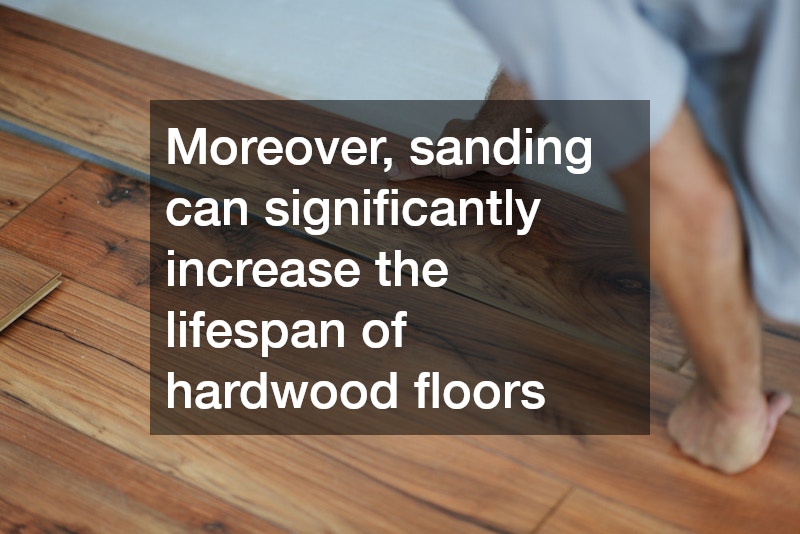Hardwood floors add a timeless elegance and durability to homes, but over time, they can lose their shine and develop scratches or dents. This is where the importance of professionally sanding hardwood floors becomes evident. The process not only rejuvenates the look of the floors but also extends their lifespan, safeguarding your investment.
By smoothing the surface and removing imperfections, sanding facilitates a better finish, after which the floor can be stained or sealed to protect the wood and enhance its aesthetic appeal. Professional sanding ensures that the job is done with precision, using the right techniques and equipment that typically aren’t available to amateurs.
1. Why is Sanding Hardwood Floors Necessary?
Sanding hardwood floors is crucial for several reasons, primarily revolving around maintaining the beauty and structural integrity of the floors. Over time, hardwood floors can suffer from scratches, dents, and general wear and tear due to foot traffic, furniture movement, and environmental factors. Sanding removes these imperfections, revealing a fresh layer of wood beneath. This not only brings back the floor’s original beauty but also prepares it for refinishing, further protecting the wood from future damage.
Moreover, sanding can significantly increase the lifespan of hardwood floors. Addressing minor damages early on prevents them from developing into more severe issues that could require costly repairs or even complete replacement. Sanding also keeps the floor level, which is essential for maintaining the structural stability and safety of the flooring. Periodic refinishing through sanding can effectively refresh your floors, offering a clean slate for any future customization or color changes.
In addition to aesthetic and durability benefits, sanding improves indoor air quality by eliminating accumulations of dust, allergens, and other airborne particles that settle into the grooves and cracks of the wood. As these particles build up over time, they can contribute to an unhealthy living environment, particularly for individuals with allergies or respiratory issues. By removing the top layers of the wood where these particles tend to gather, sanding promotes a healthier home environment.
2. What Equipment is Used in Professional Sanding?
Professional sanding of hardwood floors requires specialized equipment designed to handle the nuances of various hardwood types and floor conditions. The primary tool used is the drum sander, a powerful machine capable of removing several layers of wood in one pass. A drum sander is essential for tackling the initial rough sanding phase, removing deep scratches and leveling the surface effectively. It requires skilled operation to ensure even results and prevent accidental damage to the floors.
Edging sanders are another critical piece of equipment used by professionals to sand areas that the drum sander cannot reach, such as corners and along baseboards. These smaller sanders provide the precision needed to ensure that every inch of the floor is sanded uniformly. Additionally, professionals may use orbital sanders to achieve a smooth finish during the final sanding phase. Orbital sanders offer more control and finesse, perfect for achieving the fine, even surface needed for subsequent staining or sealing.
To complement the various sanding machines, professionals utilize a range of sandpaper grits, starting from coarse to fine. This gradation helps ensure that each phase of sanding transitions smoothly into the next, ultimately achieving the optimal surface texture for refinishing. Moreover, advanced equipment such as dustless sanding systems can be employed, significantly reducing the amount of dust generated during the process, which benefits both the homeowners and the workers.
3. How Often Should Hardwood Floors Be Sanded?
The frequency of sanding hardwood floors depends on several factors, including the type of wood, the floor’s exposure to wear and tear, and the homeowner’s preferred level of maintenance. Generally, most hardwood floors benefit from a professional sanding and refinishing every seven to ten years. However, high-traffic areas in homes with pets or children might require more frequent attention, while less-used rooms could extend beyond this timeframe.
Additionally, the condition of the existing floor finish plays a significant role in determining the sanding schedule. Floors that start showing visible signs of wear, such as deep scratches, discoloration, or dullness, might need sanding sooner. Regular inspections of the floors can help homeowners decide the optimal timing, ensuring that minor imperfections do not evolve into more significant issues. The general appearance of the floor, combined with its functional state, provides a reliable guideline.
Moreover, the type of finish currently on the floor influences sanding frequency. For instance, floors finished with high-gloss polyurethane might show scratches and wear more quickly, while those with matte finishes can hide imperfections for longer periods. Consulting with a professional can provide homeowners with personalized advice based on their specific floor type and lifestyle, tailoring a maintenance plan that maximizes both aesthetics and longevity.
Professional sanding of hardwood floors is an essential maintenance practice that preserves and enhances the beauty and durability of your investment. Understanding the necessity of sanding, the equipment and techniques involved, and the importance of selecting the right professional service can make a significant difference in the outcome. A thoughtfully executed sanding process not only rejuvenates your floors but also contributes to a healthier indoor environment. By incorporating these insights into your home maintenance routine, you can enjoy the timeless appeal and functionality of hardwood floors for years to come.





